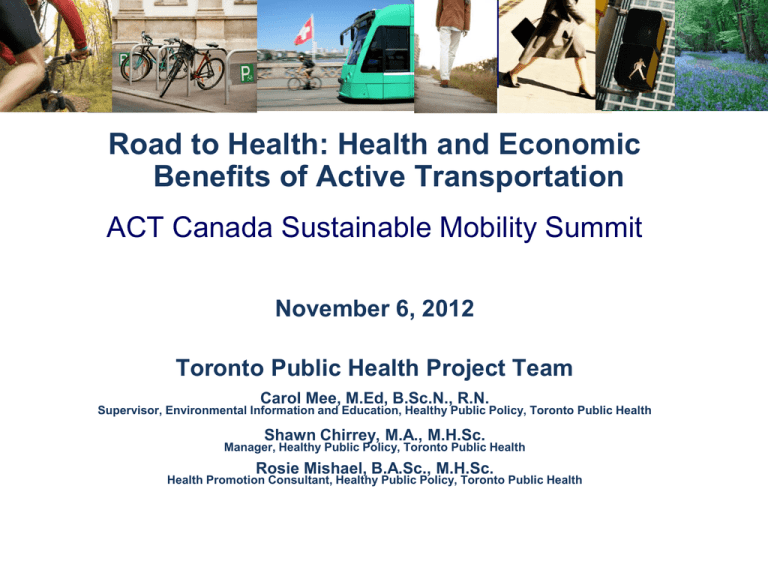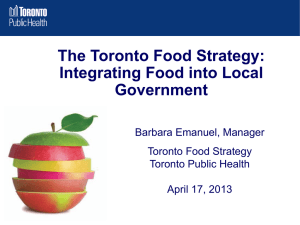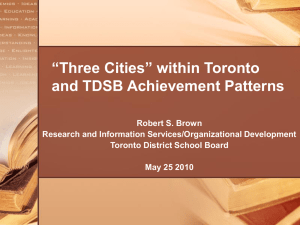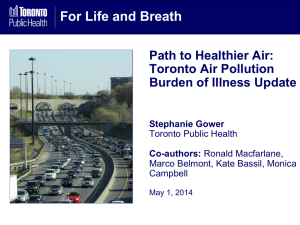Health and Economic Benefits of Active Transportation
advertisement

Road to Health: Health and Economic Benefits of Active Transportation ACT Canada Sustainable Mobility Summit November 6, 2012 Toronto Public Health Project Team Carol Mee, M.Ed, B.Sc.N., R.N. Supervisor, Environmental Information and Education, Healthy Public Policy, Toronto Public Health Shawn Chirrey, M.A., M.H.Sc. Manager, Healthy Public Policy, Toronto Public Health Rosie Mishael, B.A.Sc., M.H.Sc. Health Promotion Consultant, Healthy Public Policy, Toronto Public Health Acknowledgements Key Study Participants and Advisors: • City of Toronto Transportation Services - Dan Egan, Christine Bouchard, Janet Lo, and Fiona Chapman • Heart & Stroke Foundation - Matthew Mayer • Ontario Medical Association, Kathryn MacKay and John Wellner • YMCA/Get Active Toronto - Catriona Delaney • IndEco - David Heeney, Deborah Lightman, and Meghan Winters 2 Outline • Overview of Road to Health • Using the results: collaborating with others 3 Road to Health: Improving Walking & Cycling in Toronto • Active Transportation (AT) as means to improve health in Toronto • Benefits of walking and cycling • Collisions, injuries and fatalities and their costs • Distribution of health benefits and risks • Strategies to increase walking and cycling in Toronto 4 Health Burden of Obesity and Injury • Obesity increase the risk of many chronic diseases Over 40% of adults in Toronto were overweight or obese (2008) • Injuries Over 3,400 pedestrians and cyclists are injured or die each year from collisions with motor vehicles 5 Travel Choices and Obesity Rates Table 1: Travel Options & Obesity - Toronto & Outer GTA Variable Toronto Obese (BMI>30) (%) 18.2 Outer GTA 24.6 Walk for utilitarian reasons (days/week) 3.4 1.7 Use Public Transit (days/week) 2.3 0.6 Use Automobile (days/week) 3.4 5.7 Vehicle kilometres travelled (VKT) 192 344 6 Health Benefits and Shifting Modal Share Population-level relationship between obesity and combined walking, cycling, and transit mode share Source: Transport Canada (2010), data from Basset et al. (2008) 7 Health Benefits of Active Transportation • Decrease in CVD, type 2 diabetes, cancer • Reduced morbidity & mortality • Reduced air & noise pollution • Reduced collisions 8 Social Benefits of Active Transportation • Neighbourhood safety • Sense of community • Real estate value • Local economic activity • Job creation Photo: Parent, Worldneighbourhoods.com 9 Risks of Walking & Cycling in Toronto • Pedestrians account for more than half of all fatalities from vehicle collisions • Cyclists account for 6% of injuries from collisions, despite a mode share of less than 2% • Toronto is less safe for pedestrians and cyclists than other cities Photo: Parent, Worldneighbourhoods.com 10 Improving Walking and Cycling in Toronto • Only 5% of Toronto’s transportation capital spent on walking/cycling projects • Toronto is making progress, but lags behind other leading cities in many ways 11 AT in Toronto vs. Other Cities Walking mode shares 7.1% Toronto 7.8% Ottawa 12.3% 10.3% 10.3% New York San Francisco 11.1% 8.6% Montreal Washington Vancouver 5.8% Cycling mode shares 3.7% 1.7% Toronto 2.2% 2.2% 2.4% Ottawa Washington Montreal 3.0% San Francisco Vancouver Portland 12 Quantifying the health benefits of active transportation 13 Potential Reductions in Mortality in Toronto Walking and cycling mode shares of 12% and 6% would prevent at least 100 more deaths per year Photo: Parent, Worldneighbourhoods.com 14 Economic Benefits of Active Transportation Reductions in congestion and vehicle emissions Economic benefits of physical activity Increases in property value Reductions in costs of pedestrian / cyclist collisions Increases in tourism, economic activity and jobs Increases in quality of life 15 Economic Benefits of Physical Activity Reduced medical costs Reduced mortality Increased physical activity Reduced risk of chronic disease. Reduced economic output loss Reduced medical costs Reduced morbidity Reduced economic output loss 16 Collisions in Toronto • Injure > 1,000 cyclists and 2,000 pedestrians each year • $62 million in direct and indirect costs Collisions per 1,000 active commuters 64 37 32 25 20 19 11 Toronto Ottawa Cyclists Montreal 11 Vancouver Pedestrians 17 Reducing the Costs of Collisions Pedestrian Fatalities (%) 100% 80% 60% 40% 20% 0% 10 20 30 40 50 60 Impact Speed (km/h) 18 Road to Health: Key Recommendations • Reduce vehicle speeds • Create advanced crossings • Increase funding for infrastructure • Set goals and targets for increased safety and mode shares 19 Using the Results: Collaborating with others 20 Creating an “Active City” • Active Transportation Demonstration program Collaboration with Transportation Services Examine measures such as reduced speed limits, traffic calming, safer intersections, etc. in selected neighbourhoods Photo: Parent, Worldneighbourhoods.com 21 Creating a Healthy City by Design • The Walkable City – CLASP partners, Transportation Services • Creating Healthy Built Environment: Highlights of Best Practices in Toronto – Planning, Environment Office, and others • Road to Health: Improving Walking and Cycling in Toronto – Transportation Services • Toward Healthier Apartment Neighbourhoods - Planning, Tower Renewal, United Way 22 For More Information Toronto Public Health Build Environment web http://www.toronto.ca/health/hphe/built _environment.htm Carol Mee cmee@toronto.ca 23






